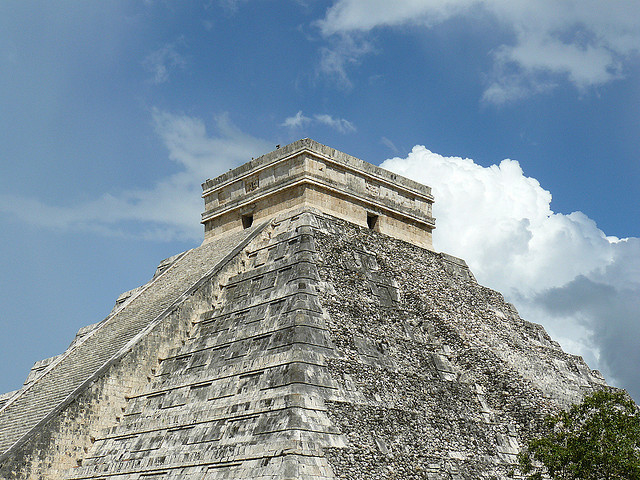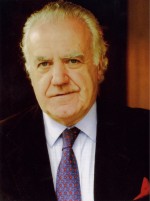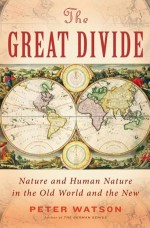
In Squaring Off, Zócalo invites authors into the public square to answer five questions about the essence of their books. For this round, we pose questions to intellectual historian Peter Watson, author of The Great Divide: History and Human Nature in the Old World and the New (HarperCollins).
Nearly 10,000 years ago, the Bering land bridge melted for the last time, keeping humans in Eurasia and the Americas entirely isolated from each other until the discovery of the New World. Watson argues that the divergent development of humankind in these separated hemispheres was heavily influenced by three factors: climate, domesticable animals, and hallucinogenic plants.
1) In your author’s note, you mention that the 2009 Aztec Exhibition at the British Museum led some critics to compare Aztec practices to Nazi atrocities. Do the Aztecs need an apologist-and do you aim for your book to play that role?

The responses to the British Museum exhibition that I mentioned were extreme, but they were not the views of uneducated men; so yes, some correction is needed in some quarters. My book seeks to situate cultures and civilizations within factors that make behavior that some may see as extraordinary comprehensible. Civilizations may be understood as adaptations to environment and history, which lead to varying views of human nature. I just hope my book puts a little more order into our perceptions of the very varied differences between the peoples of the Old world and the New.
2) What environmental factors unique to Latin America led to the formation of complex civilizations there and not in the northern part of the continent?
The potato and other cultivated plants adapted to the height and cold of the Andes-but the mountain range made it difficult for them to spread further. The llama, a beast of burden, is native to the southern part of the continent. In Latin America but not further north you also find coca, a stimulant that allowed people to adapt to the mountains. The height and cold meant there were few diseases. And the increasing frequency of El Niño stimulated people to come together to combat its effects.
3) You argue that the religions of the New World-especially their emphasis on violent deities and human sacrifice-are the result of the presence of destructive weather and hallucinogenic plants. How did these two forces interact with and feed into each other?

There are several psychoanalytic/psychological theories about sacrifice, which I reject. Destructive weather-earthquakes, volcanoes, El Niño winds, and tsunamis-consume people, either whole or in part, so that a lot of blood is strewn around. This is what makes so-called primitive people think that the gods demand human bodies and blood, giving rise to the idea of sacrifice. In the Old world the presence of domesticable mammals put an end to human sacrifice. Animals like sheep and goats had already been domesticated, and were therefore available to be used instead of humans. This wasn’t true in large stretches of the New world where the dominant animals (jaguar, bison, salmon) were wild. Hallucinogens allowed holy men-shamans-to manipulate these events.
4) You suggest that humans only made the connection between sexual intercourse and birth around 12,000 years ago, when they domesticated mammals with shorter pregnancies. What is the evidence that the link hadn’t been made before then?
I know this is counter-intuitive; it seems very late for the link to have been made then, and if evidence emerges that the link had been made before, I shall have to abandon my theory. Here are three pieces of evidence:
1.Until 12,000 or 11,000 years ago, mobile hunter-gatherers carried Venus figurines, which I believe to be devices to record when a woman was about to give birth because people weren’t aware of the reproductive cycle.
2. In Middle Eastern civilizations, burials are communal until around 12,000 years ago. After that, burials occur beneath houses, and the idea of the restricted family is born; I think this is because the notion of paternity arises then. In my view, communal burials indicate that previously there was no idea of a specific father.
3. I quote specific evidence from Australia that aborigines did not associate sexual intercourse with birth until they domesticated the dingo, a form of dog, with a similarly short pregnancy period.
5) In our globalized world, do local environmental factors have anywhere near the influence of those that shaped pre-Columbian civilizations in Eurasia and the Americas? Do your theories apply in the contemporary age?
I think the short answer is that local factors do not have the same effect nowadays as they used to. Culture overall is becoming homogenized. But you can still see the effects of environmental factors on our world today:
1. After the “discovery” of the New World, scholars talk of a Columbian Exchange, when Europe gave some things to the Americas (eg. domesticable mammals, Christianity, science) and the New World gave certain things to Europe. We can say at this distance that four things stand out, three wholly good, the fourth less so. The three good things are the potato, maize, and the tomato, each of which is now grown all over the world with great success, and has helped many countries, rich and poor, prosper. The less good thing is hallucinogenic drugs, especially coca and cocaine.
2. Several historians have advanced the view that true democracy has only developed in countries where Christianity has flourished, because only in Christian theology does the idea that we are all equal before God run deep. This is obviously controversial, but I think there is something to it.
3. Examining contemporary religion, with the exception of the United States (which has always been the odd-man-out in religious terms), you find that it’s strongest in areas low in what is called “existential security.” These are invariably countries with destructive weather (tsunamis, El Niño, earthquakes, volcanoes, monsoons, and tornadoes) where drought and famine are common. You will see that this is an extension-worldwide-of my argument that religion arises naturally out of environmental factors.
Buy the book: Skylight, Powell’s, Amazon.
*Photo courtesy of Mike_fleming.



